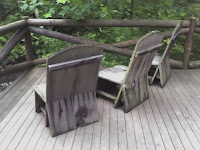
Continuing with our July 5 hike... After passing Big Rock Falls, it is only a short distance into Rapidan Camp. This historical site sits in a relatively flat area at the confluence of the Laurel and Mills Prongs, and is also where the Rapidan River starts.
The Hoovers chose this site based on three criteria: 1) the retreat needed to be within 100 miles of Washington, DC; 2) the minimum altitude was to be above 2,500 feet to eliminate mosquitoes; and 3) a trout stream had to be immediately accessible. They bought the land with their own money and paid for many of the improvements, augmented by the Marines who built some of the improvements as training.
We walked down to the “Brown House,” or Presidential Cabin, where we sat in these chairs, overlooking the rustic bridge, and had some sandwiches. The b
 ridge is rebuilt, but there are pictures of Hoover posing on it. Also, the chairs are of the original design, and the publications say that Hoover often sat out on this deck enjoying the stream.
ridge is rebuilt, but there are pictures of Hoover posing on it. Also, the chairs are of the original design, and the publications say that Hoover often sat out on this deck enjoying the stream.One other note about this spot, Roosevelt visited the camp as the Hoovers had dedicated it to successor Presidents. The camp was difficult for Roosevelt to get to, and get around in. But it is said that he sat in this spot to consider whether or not to use the site for his own retreats; he preferred Georgia, New York, and Maryland for this purpose and never returned.
Over the four years of Hoover’s term, he spent most summer weekends here.
Notable visitors included the Prime Minister of England, who was on a state visit to discuss naval arms limitations. This cabin is known as the Prime Minister Cabin and includes excellent interpretive displays.
Also, as the Depression advanced, Hoover was very involved in arranging financing for bank rescues during his stays here.

Finally, the large outdoor fireplace here and in the first photo above was used for photographs and for gatherings in the evening. As luck would have it, my phone cam shot illustrates how the design of this fireplace was repeated in the cabins and other buildings. The camp was used during three seasons eventually, but it immediately fell into disuse at the end of the Hoover administration.
We bought a little history book at the Big Meadow ranger store and I read it Sunday. The camp had as many as 22 structures for guests at one time, but only three remain. There was an entire separate camp for the Marines who stayed in the Park while the Hoovers were there. Also, as they got to know some of the mountain people in the area, the Hoovers built a schoolhouse to educate them.
The property was eventually used by the Boy Scouts in the 1950’s, but without a swimming pool, it wasn’t as well used as some of the other properties they had access to, and the facility was eventually turned over to the National Park Service for management. Today there is a volunteer who resides on-site in “The Creel,” one of the original buildings.
There is a good review of the hike on Hiking Upward (http://www.hikingupward.com/ - search for Camp Hoover) and of course additional historical information at Wikipedia.



No comments:
Post a Comment